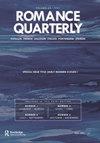Nuvole barocche: Clouds as synesthetic metaphors across baroque poetry and music
IF 0.2
3区 文学
0 LITERATURE, ROMANCE
引用次数: 0
Abstract
Abstract In his 1961 song “Nuvole barocche” (Baroque Clouds), Italian songwriter Fabrizio De André commented on the fascination exerted by colorful clouds at sunset and their artistic representation as canonized by the visual culture of the baroque, fittingly emblematized by the transience of clouds themselves. The domain of the visual is turned into that of the acoustic, triggering the synesthetic interaction of forms of sense perception, which are usually conceived as separate from one another. The song thus reminds us that the polysemous nature of clouds makes them particularly suitable for forms of artistic representation that, moving across mediums, blur the boundaries of sense perception. This essay looks at how such interplay of sensory layers actually works and to what extent it fits the rhetoric and poetics of the Baroque. In order to do so, I chase the sound of baroque clouds through arias and songs that play with the ambiguous semantics of meteorology and make the singing voice convey anxieties about topics as diverse as the course of time, the volatility of love, devotional and spiritual concerns. After framing the discussion in rhetorical terms, with a focus on metaphors and similes, the essay examines works by John Dowland, Francesca Caccini, Sigimsondo D’India, and George Frideric Handel in order to assess some of the ways in which the unstable nature of clouds lends itself to a kind of metaphoric code that is best described in synesthetic terms.云在巴洛克诗歌和音乐中的联觉隐喻
意大利作曲家法布里齐奥·德·安德烈(Fabrizio De andr)在其1961年的歌曲《巴洛克的云》(Nuvole barocche)中评论了日落时彩云的魅力,并将其艺术表现形式视为巴洛克视觉文化的经典,并恰如其分地以云本身的短暂性作为象征。视觉的领域变成了听觉的领域,触发了感官知觉形式的联觉相互作用,这些形式通常被认为是彼此分离的。因此,这首歌提醒我们,云的多义性使它们特别适合于艺术表现形式,通过跨媒介移动,模糊了感官感知的界限。这篇文章着眼于这些感官层次的相互作用是如何运作的,以及它在多大程度上符合巴洛克风格的修辞和诗学。为了做到这一点,我通过咏叹调和歌曲来追逐巴洛克云的声音,这些咏叹调和歌曲与气象学的模糊语义一起玩,并使歌声传达对各种主题的焦虑,如时间的进程,爱情的波动,虔诚和精神上的关注。在以修辞术语为讨论框架,重点关注隐喻和明喻之后,本文考察了约翰·道兰德、弗朗西斯卡·卡奇尼、西格曼松多·迪因迪亚和乔治·弗里德里希·亨德尔的作品,以评估云的不稳定性质如何使自己成为一种隐喻代码,这种隐喻代码最好用联感术语来描述。
本文章由计算机程序翻译,如有差异,请以英文原文为准。
求助全文
约1分钟内获得全文
求助全文
来源期刊

ROMANCE QUARTERLY
LITERATURE, ROMANCE-
CiteScore
0.30
自引率
50.00%
发文量
18
期刊介绍:
Lorca and Baudelaire, Chrétien de Troyes and Borges. The articles in Romance Quarterly provide insight into classic and contemporary works of literature originating in the Romance languages. The journal publishes historical and interpretative articles primarily on French and Spanish literature but also on Catalan, Italian, Portuguese, and Brazilian literature. RQ contains critical essays and book reviews, mostly in English but also in Romance languages, by scholars from universities all over the world. Romance Quarterly belongs in every department and library of Romance languages.
 求助内容:
求助内容: 应助结果提醒方式:
应助结果提醒方式:


